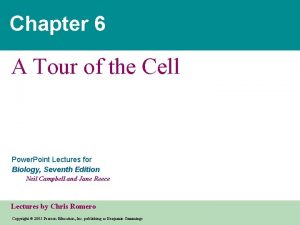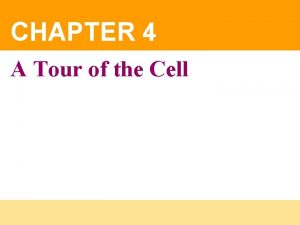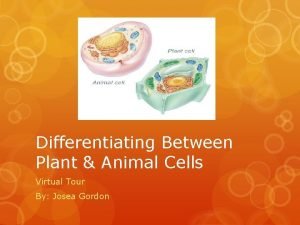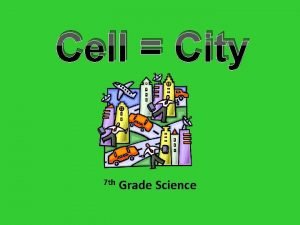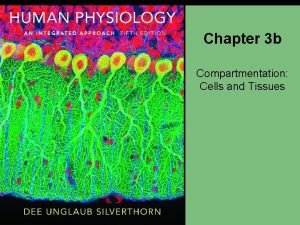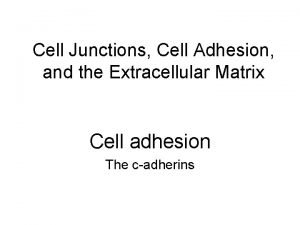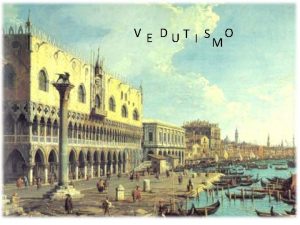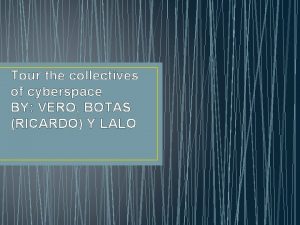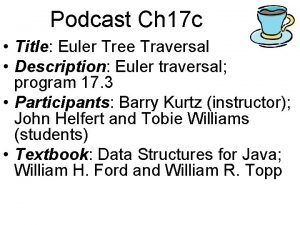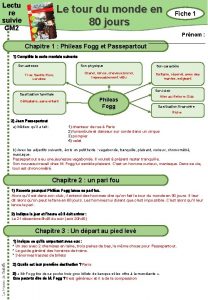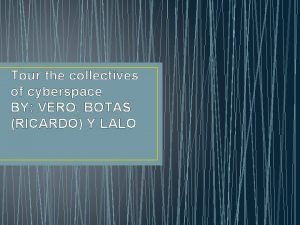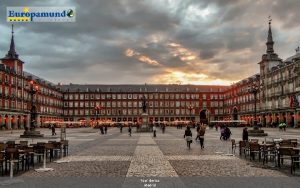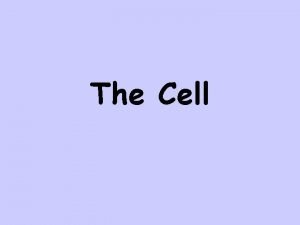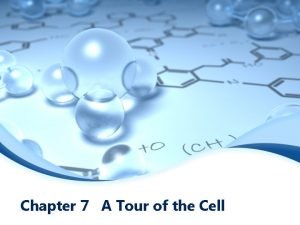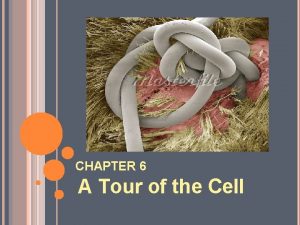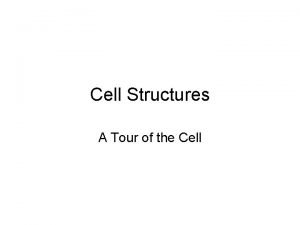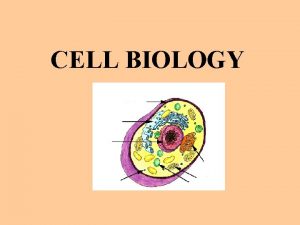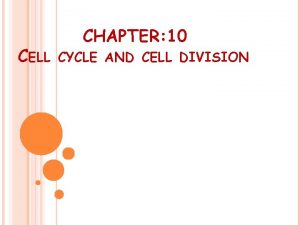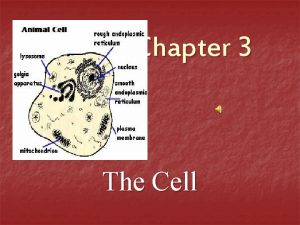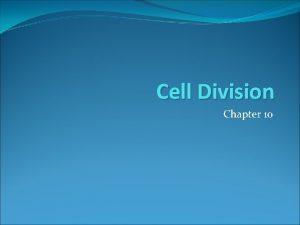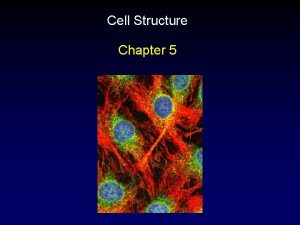Chapter 6 A Tour of the Cell The













































































- Slides: 77

Chapter 6 A Tour of the Cell The Cell: A Living Unit Greater Than the Sum of Its Parts • Cells rely on the integration of structures and organelles in order to function • For example, a macrophage’s ability to destroy bacteria involves the whole cell, coordinating components such as the cytoskeleton, lysosomes, and plasma membrane Copyright © 2008 Pearson Education, Inc. , publishing as Pearson Benjamin Cummings

5 µm Fig. 6 -33

You should now be able to: 1. Distinguish between the following pairs of terms: magnification and resolution; prokaryotic and eukaryotic cell; free and bound ribosomes; smooth and rough ER 2. Describe the structure and function of the components of the endomembrane system 3. Briefly explain the role of mitochondria, chloroplasts, and peroxisomes 4. Describe the functions of the cytoskeleton Copyright © 2008 Pearson Education, Inc. , publishing as Pearson Benjamin Cummings

5. Compare the structure and functions of microtubules, microfilaments, and intermediate filaments 6. Explain how the ultrastructure of cilia and flagella relate to their functions 7. Describe the structure of a plant cell wall 8. Describe the structure and roles of the extracellular matrix in animal cells 9. Describe the intercellular junctions Copyright © 2008 Pearson Education, Inc. , publishing as Pearson Benjamin Cummings

Overview: The Fundamental Units of Life • All organisms are made of cells- cell theory • The cell is the simplest collection of matter that can live • Cell structure is correlated to cellular function • All cells are related by their descent from earlier cells Copyright © 2008 Pearson Education, Inc. , publishing as Pearson Benjamin Cummings

Microscopy • Scientists use microscopes to visualize cells too small to see with the naked eye • In a light microscope (LM), visible light passes through a specimen and then through glass lenses, which magnify the image Copyright © 2008 Pearson Education, Inc. , publishing as Pearson Benjamin Cummings

10 m Human height Length of some nerve and muscle cells 0. 1 m Chicken egg 1 cm 100 µm 10 µm Most plant and animal cells Nucleus Most bacteria 1 µm 100 nm 1 nm 0. 1 nm Mitochondrion Smallest bacteria Viruses Ribosomes Proteins Lipids Small molecules Atoms Electron microscope 1 mm Frog egg Light microscope 1 m Unaided eye Fig. 6 -2

• Two basic types of electron microscopes (EMs) are used to study subcellular structures • Scanning electron microscopes (SEMs) focus a beam of electrons onto the surface of a specimen, providing images that look 3 -D • Transmission electron microscopes (TEMs) focus a beam of electrons through a specimen • TEMs are used mainly to study the internal structure of cells Copyright © 2008 Pearson Education, Inc. , publishing as Pearson Benjamin Cummings

Fig. 6 -4 TECHNIQUE (a) Scanning electron microscopy (SEM) RESULTS Cilia 1 µm (b) Transmission electron Longitudinal Cross section of of cilium microscopy (TEM) 1 µm cilium

Fig. 6 -5 a TECHNIQUE Homogenization Tissue cells Differential centrifugation Homogenate

Concept 6. 2: Eukaryotic cells have internal membranes that compartmentalize their functions • The basic structural and functional unit of every organism is one of two types of cells: prokaryotic or eukaryotic • Only organisms of the domains Bacteria and Archaea consist of prokaryotic cells • Protists, fungi, animals, and plants all consist of eukaryotic cells Copyright © 2008 Pearson Education, Inc. , publishing as Pearson Benjamin Cummings

Comparing Prokaryotic and Eukaryotic Cells • Basic features of all cells: – Plasma membrane – Semifluid substance called cytosol – Chromosomes (carry genes) – Ribosomes (make proteins) Copyright © 2008 Pearson Education, Inc. , publishing as Pearson Benjamin Cummings

• Prokaryotic cells are characterized by having – No nucleus – DNA in an unbound region called the nucleoid – No membrane-bound organelles – Cytoplasm bound by the plasma membrane Copyright © 2008 Pearson Education, Inc. , publishing as Pearson Benjamin Cummings

Fig. 6 -6 Fimbriae Nucleoid Ribosomes Plasma membrane Bacterial chromosome (a) A typical rod-shaped bacterium Cell wall Capsule Flagella 0. 5 µm (b) A thin section through the bacterium Bacillus coagulans (TEM)

• Eukaryotic cells are characterized by having – DNA in a nucleus that is bounded by a membranous nuclear envelope – Membrane-bound organelles – Cytoplasm in the region between the plasma membrane and nucleus • Eukaryotic cells are generally much larger than prokaryotic cells Copyright © 2008 Pearson Education, Inc. , publishing as Pearson Benjamin Cummings

• The plasma membrane is a selective barrier that allows sufficient passage of oxygen, nutrients, and waste to service the volume of every cell • The general structure of a biological membrane is a double layer of phospholipids Copyright © 2008 Pearson Education, Inc. , publishing as Pearson Benjamin Cummings

Fig. 6 -7 Outside of cell Inside of cell 0. 1 µm (a) TEM of a plasma membrane Carbohydrate side chain Hydrophilic region Hydrophobic region Hydrophilic region Phospholipid Proteins (b) Structure of the plasma membrane

A Panoramic View of the Eukaryotic Cell • A eukaryotic cell has internal membranes that partition the cell into organelles • Plant and animal cells have most of the same organelles Bio. Flix: Tour Of An Animal Cell Bio. Flix: Tour Of A Plant Cell Copyright © 2008 Pearson Education, Inc. , publishing as Pearson Benjamin Cummings

Fig. 6 -9 a ENDOPLASMIC RETICULUM (ER) Flagellum Rough ER Smooth ER Nuclear envelope NUCLEUS Nucleolus Chromatin Centrosome Plasma membrane CYTOSKELETON: Microfilaments Intermediate filaments Microtubules Ribosomes Microvilli Golgi apparatus Peroxisome Mitochondrion Lysosome

Fig. 6 -9 b NUCLEUS Nuclear envelope Nucleolus Chromatin Rough endoplasmic reticulum Smooth endoplasmic reticulum Ribosomes Central vacuole Golgi apparatus Microfilaments Intermediate filaments Microtubules Mitochondrion Peroxisome Chloroplast Plasma membrane Cell wall Wall of adjacent cell Plasmodesmata CYTOSKELETON

Concept 6. 3: The eukaryotic cell’s genetic instructions are housed in the nucleus and carried out by the ribosomes • The nucleus contains most of the DNA in a eukaryotic cell • Ribosomes use the information from the DNA to make proteins Copyright © 2008 Pearson Education, Inc. , publishing as Pearson Benjamin Cummings

Fig. 6 -10 Nucleus 1 µm Nucleolus Chromatin Nuclear envelope: Inner membrane Outer membrane Nuclear pore Pore complex Surface of nuclear envelope Rough ER Ribosome 1 µm 0. 25 µm Close-up of nuclear envelope Pore complexes (TEM) Nuclear lamina (TEM)

• In the nucleus, DNA and proteins form genetic material called chromatin • Chromatin condenses to form discrete chromosomes • The nucleolus is located within the nucleus and is the site of ribosomal RNA (r. RNA) synthesis Copyright © 2008 Pearson Education, Inc. , publishing as Pearson Benjamin Cummings

Concept 6. 4: The endomembrane system regulates protein traffic and performs metabolic functions in the cell • Components of the endomembrane system: – Nuclear envelope – Endoplasmic reticulum – Golgi apparatus – Lysosomes – Vacuoles – Plasma membrane • These components are either continuous or connected via transfer by vesicles Copyright © 2008 Pearson Education, Inc. , publishing as Pearson Benjamin Cummings

The Endoplasmic Reticulum: Biosynthetic Factory • The endoplasmic reticulum (ER) accounts for more than half of the total membrane in many eukaryotic cells • The ER membrane is continuous with the nuclear envelope • There are two distinct regions of ER: – Smooth ER, which lacks ribosomes – Rough ER, with ribosomes studding its surface Copyright © 2008 Pearson Education, Inc. , publishing as Pearson Benjamin Cummings

Fig. 6 -12 Smooth ER Rough ER ER lumen Cisternae Ribosomes Transport vesicle Smooth ER Nuclear envelope Transitional ER Rough ER 200 nm

Ribosomes: Protein Factories • Ribosomes are particles made of ribosomal RNA and protein • Ribosomes carry out protein synthesis in two locations: – In the cytosol (free ribosomes) – On the outside of the endoplasmic reticulum or the nuclear envelope (bound ribosomes) Copyright © 2008 Pearson Education, Inc. , publishing as Pearson Benjamin Cummings

Fig. 6 -11 Cytosol Endoplasmic reticulum (ER) Free ribosomes Bound ribosomes Large subunit 0. 5 µm TEM showing ER and ribosomes Small subunit Diagram of a ribosome

Functions of Smooth ER • The smooth ER – Synthesizes lipids – Metabolizes carbohydrates – Detoxifies poison – Stores calcium Copyright © 2008 Pearson Education, Inc. , publishing as Pearson Benjamin Cummings

Functions of Rough ER • The rough ER – Has bound ribosomes, which secrete glycoproteins (proteins covalently bonded to carbohydrates) – Distributes transport vesicles, proteins surrounded by membranes – Is a membrane factory for the cell Copyright © 2008 Pearson Education, Inc. , publishing as Pearson Benjamin Cummings

The Golgi Apparatus: Shipping and Receiving Center • The Golgi apparatus consists of flattened membranous sacs called cisternae • Functions of the Golgi apparatus: – Modifies products of the ER – Manufactures certain macromolecules – Sorts and packages materials into transport vesicles Copyright © 2008 Pearson Education, Inc. , publishing as Pearson Benjamin Cummings

Fig. 6 -13 cis face (“receiving” side of Golgi apparatus) 0. 1 µm Cisternae trans face (“shipping” side of Golgi apparatus) TEM of Golgi apparatus

Lysosomes: Digestive Compartments • A lysosome is a membranous sac of hydrolytic enzymes that can digest macromolecules • Lysosomal enzymes can hydrolyze proteins, fats, polysaccharides, and nucleic acids Animation: Lysosome Formation Copyright © 2008 Pearson Education, Inc. , publishing as Pearson Benjamin Cummings

• Some types of cell can engulf another cell by phagocytosis; this forms a food vacuole • A lysosome fuses with the food vacuole and digests the molecules • Lysosomes also use enzymes to recycle the cell’s own organelles and macromolecules, a process called autophagy Copyright © 2008 Pearson Education, Inc. , publishing as Pearson Benjamin Cummings

Fig. 6 -14 a Nucleus 1 µm Lysosome Digestive enzymes Plasma membrane Digestion Food vacuole (a) Phagocytosis

Fig. 6 -14 b Vesicle containing two damaged organelles 1 µm Mitochondrion fragment Peroxisome fragment Lysosome Peroxisome Vesicle (b) Autophagy Mitochondrion Digestion

Vacuoles: Diverse Maintenance Compartments • A plant cell or fungal cell may have one or several vacuoles Copyright © 2008 Pearson Education, Inc. , publishing as Pearson Benjamin Cummings

• Food vacuoles are formed by phagocytosis • Contractile vacuoles, found in many freshwater protists, pump excess water out of cells • Central vacuoles, found in many mature plant cells, hold organic compounds and water Video: Paramecium Vacuole Copyright © 2008 Pearson Education, Inc. , publishing as Pearson Benjamin Cummings

Fig. 6 -15 Central vacuole Cytosol Nucleus Central vacuole Cell wall Chloroplast 5 µm

The Endomembrane System: A Review • The endomembrane system is a complex and dynamic player in the cell’s compartmental organization Copyright © 2008 Pearson Education, Inc. , publishing as Pearson Benjamin Cummings

Fig. 6 -16 -3 Nucleus Rough ER Smooth ER cis Golgi trans Golgi Plasma membrane

Concept 6. 5: Mitochondria and chloroplasts change energy from one form to another • Mitochondria are the sites of cellular respiration, a metabolic process that generates ATP • Chloroplasts, found in plants and algae, are the sites of photosynthesis • Peroxisomes are oxidative organelles Copyright © 2008 Pearson Education, Inc. , publishing as Pearson Benjamin Cummings

• Mitochondria and chloroplasts – Are not part of the endomembrane system – Have a double membrane – Have proteins made by free ribosomes – Contain their own DNA Copyright © 2008 Pearson Education, Inc. , publishing as Pearson Benjamin Cummings

Mitochondria: Chemical Energy Conversion • Mitochondria are in nearly all eukaryotic cells • They have a smooth outer membrane and an inner membrane folded into cristae • The inner membrane creates two compartments: intermembrane space and mitochondrial matrix • Some metabolic steps of cellular respiration are catalyzed in the mitochondrial matrix • Cristae present a large surface area for enzymes that synthesize ATP Copyright © 2008 Pearson Education, Inc. , publishing as Pearson Benjamin Cummings

Fig. 6 -17 Intermembrane space Outer membrane Free ribosomes in the mitochondrial matrix Inner membrane Cristae Matrix 0. 1 µm

Chloroplasts: Capture of Light Energy • The chloroplast is a member of a family of organelles called plastids • Chloroplasts contain the green pigment chlorophyll, as well as enzymes and other molecules that function in photosynthesis • Chloroplasts are found in leaves and other green organs of plants and in algae Copyright © 2008 Pearson Education, Inc. , publishing as Pearson Benjamin Cummings

• Chloroplast structure includes: – Thylakoids, membranous sacs, stacked to form a granum – Stroma, the internal fluid Copyright © 2008 Pearson Education, Inc. , publishing as Pearson Benjamin Cummings

Fig. 6 -18 Ribosomes Stroma Inner and outer membranes Granum Thylakoid 1 µm

Fig. 6 -19 Chloroplast Peroxisome Mitochondrion 1 µm

Concept 6. 6: The cytoskeleton is a network of fibers that organizes structures and activities in the cell • The cytoskeleton is a network of fibers extending throughout the cytoplasm • It organizes the cell’s structures and activities, anchoring many organelles • It is composed of three types of molecular structures: – Microtubules – Microfilaments – Intermediate filaments Copyright © 2008 Pearson Education, Inc. , publishing as Pearson Benjamin Cummings

Fig. 6 -20 Microtubule 0. 25 µm Microfilaments

Roles of the Cytoskeleton: Support, Motility, and Regulation • The cytoskeleton helps to support the cell and maintain its shape • It interacts with motor proteins to produce motility • Inside the cell, vesicles can travel along “monorails” provided by the cytoskeleton • Recent evidence suggests that the cytoskeleton may help regulate biochemical activities Copyright © 2008 Pearson Education, Inc. , publishing as Pearson Benjamin Cummings

Fig. 6 -21 ATP (a) Receptor for motor protein Microtubule (ATP powered) of cytoskeleton Microtubule (b) Vesicles 0. 25 µm

Components of the Cytoskeleton • Three main types of fibers make up the cytoskeleton: – Microtubules are thickest of the three components of the cytoskeleton – Microfilaments, also called actin filaments, are thinnest components – Intermediate filaments are fibers with diameters in a middle range Copyright © 2008 Pearson Education, Inc. , publishing as Pearson Benjamin Cummings

Table 6 -1 a 10 µm Column of tubulin dimers 25 nm Tubulin dimer

Table 6 -1 b 10 µm Actin subunit 7 nm

Table 6 -1 c 5 µm Keratin proteins Fibrous subunit (keratins coiled together) 8– 12 nm

Microtubules Centrosomes and Centrioles • In many cells, microtubules grow out from a centrosome near the nucleus • The centrosome is a “microtubule-organizing center” • In animal cells, the centrosome has a pair of centrioles, each with nine triplets of microtubules arranged in a ring Copyright © 2008 Pearson Education, Inc. , publishing as Pearson Benjamin Cummings

Fig. 6 -22 Centrosome Microtubule Centrioles 0. 25 µm Longitudinal section Microtubules Cross section of one centriole of the other centriole

Cilia and Flagella • Microtubules control the beating of cilia and flagella, locomotor appendages of some cells • Cilia and flagella differ in their beating patterns Video: Chlamydomonas Copyright © 2008 Pearson Education, Inc. , publishing as Pearson Benjamin Cummings Video: Paramecium Cilia

Fig. 6 -23 Direction of swimming (a) Motion of flagella 5 µm Direction of organism’s movement Power stroke Recovery stroke (b) Motion of cilia 15 µm

Fig. 6 -24 Outer microtubule doublet 0. 1 µm Dynein proteins Central microtubule Radial spoke Protein crosslinking outer doublets Microtubules Plasma membrane (b) Cross section of cilium Basal body 0. 5 µm (a) Longitudinal section of cilium 0. 1 µm Triplet (c) Cross section of basal body Plasma membrane

• How dynein “walking” moves flagella and cilia: − Dynein arms alternately grab, move, and release the outer microtubules – Protein cross-links limit sliding – Forces exerted by dynein arms cause doublets to curve, bending the cilium or flagellum Copyright © 2008 Pearson Education, Inc. , publishing as Pearson Benjamin Cummings

Fig. 6 -25 a Microtubule doublets ATP Dynein protein (a) Effect of unrestrained dynein movement

Fig. 6 -25 b ATP Cross-linking proteins inside outer doublets Anchorage in cell (b) Effect of cross-linking proteins 1 3 2 (c) Wavelike motion

Fig. 6 -26 Microvillus Plasma membrane Microfilaments (actin filaments) Intermediate filaments 0. 25 µm

Concept 6. 7: Extracellular components and connections between cells help coordinate cellular activities • Most cells synthesize and secrete materials that are external to the plasma membrane • These extracellular structures include: – Cell walls of plants – The extracellular matrix (ECM) of animal cells – Intercellular junctions Copyright © 2008 Pearson Education, Inc. , publishing as Pearson Benjamin Cummings

Cell Walls of Plants • The cell wall is an extracellular structure that distinguishes plant cells from animal cells • Prokaryotes, fungi, and some protists also have cell walls • The cell wall protects the plant cell, maintains its shape, and prevents excessive uptake of water • Plant cell walls are made of cellulose fibers embedded in other polysaccharides and protein Copyright © 2008 Pearson Education, Inc. , publishing as Pearson Benjamin Cummings

The Extracellular Matrix (ECM) of Animal Cells • Animal cells lack cell walls but are covered by an elaborate extracellular matrix (ECM) • The ECM is made up of glycoproteins such as collagen, proteoglycans, and fibronectin • ECM proteins bind to receptor proteins in the plasma membrane called integrins Copyright © 2008 Pearson Education, Inc. , publishing as Pearson Benjamin Cummings

Fig. 6 -30 a Collagen Proteoglycan complex EXTRACELLULAR FLUID Fibronectin Integrins Plasma membrane Microfilaments CYTOPLASM

• Functions of the ECM: – – Support Adhesion Movement Regulation Copyright © 2008 Pearson Education, Inc. , publishing as Pearson Benjamin Cummings

Intercellular Junctions • Neighboring cells in tissues, organs, or organ systems often adhere, interact, and communicate through direct physical contact • Intercellular junctions facilitate this contact • There are several types of intercellular junctions – Plasmodesmata – Tight junctions – Desmosomes – Gap junctions Copyright © 2008 Pearson Education, Inc. , publishing as Pearson Benjamin Cummings

Fig. 6 -31 Cell walls Interior of cell 0. 5 µm Plasmodesmata Plasma membranes

Fig. 6 -32 Tight junctions prevent fluid from moving across a layer of cells 0. 5 µm Tight junction Intermediate filaments Desmosome Gap junctions Space between cells Plasma membranes of adjacent cells Desmosome 1 µm Extracellular matrix Gap junction 0. 1 µm

Fig. 6 -UN 1 a Structure Cell Component Concept 6. 3 The eukaryotic cell’s genetic instructions are housed in the nucleus and carried out by the ribosomes Nucleus Function Surrounded by nuclear envelope (double membrane) perforated by nuclear pores. The nuclear envelope is continuous with the endoplasmic reticulum (ER). Houses chromosomes, made of chromatin (DNA, the genetic material, and proteins); contains nucleoli, where ribosomal subunits are made. Pores regulate entry and exit os materials. Two subunits made of ribosomal RNA and proteins; can be free in cytosol or bound to ER Protein synthesis (ER) Ribosome

Fig. 6 -UN 1 b Cell Component Concept 6. 4 Endoplasmic reticulum The endomembrane system (Nuclear regulates protein traffic and envelope) performs metabolic functions in the cell Golgi apparatus Lysosome Vacuole Structure Function Extensive network of membrane-bound tubules and sacs; membrane separates lumen from cytosol; continuous with the nuclear envelope. Smooth ER: synthesis of lipids, metabolism of carbohydrates, Ca 2+ storage, detoxification of drugs and poisons Stacks of flattened membranous sacs; has polarity (cis and trans faces) Rough ER: Aids in sythesis of secretory and other proteins from bound ribosomes; adds carbohydrates to glycoproteins; produces new membrane Modification of proteins, carbohydrates on proteins, and phospholipids; synthesis of many polysaccharides; sorting of Golgi products, which are then released in vesicles. Breakdown of ingested sub. Membranous sac of hydrolytic stances cell macromolecules, enzymes (in animal cells) and damaged organelles for recycling Large membrane-bounded vesicle in plants Digestion, storage, waste disposal, water balance, cell growth, and protection

Fig. 6 -UN 1 c Cell Component Concept 6. 5 Structure Function Mitochondrion Bounded by double membrane; inner membrane has infoldings (cristae) Chloroplast Photosynthesis Typically two membranes around fluid stroma, which contains membranous thylakoids stacked into grana (in plants) Peroxisome Specialized metabolic compartment bounded by a single membrane Mitochondria and chloroplasts change energy from one form to another Cellular respiration Contains enzymes that transfer hydrogen to water, producing hydrogen peroxide (H 2 O 2) as a by-product, which is converted to water by other enzymes in the peroxisome
 John jakob raskob
John jakob raskob Escort tours
Escort tours Countries michael jackson visited
Countries michael jackson visited Intercellular connections
Intercellular connections Where is the nucleoid region found
Where is the nucleoid region found A tour of the cell chapter 4
A tour of the cell chapter 4 Virtual plant cell
Virtual plant cell A tour inside the cell answers
A tour inside the cell answers Chapter 4 cell theory and cell study
Chapter 4 cell theory and cell study Golgi body school analogy
Golgi body school analogy Difference between mercury cell and diaphragm cell
Difference between mercury cell and diaphragm cell Site:slidetodoc.com
Site:slidetodoc.com Linear chromosomes in eukaryotes
Linear chromosomes in eukaryotes Venn diagram plant and animal cells
Venn diagram plant and animal cells Concentration of cells
Concentration of cells Dry cell vs wet cell
Dry cell vs wet cell Animal cells and plant cells venn diagram
Animal cells and plant cells venn diagram Middle lamella
Middle lamella Vacuole function
Vacuole function Animal vs plant cell venn diagram
Animal vs plant cell venn diagram Carbohydrate in cell membrane
Carbohydrate in cell membrane 10 cm dish surface area
10 cm dish surface area Finite and continuous cell lines
Finite and continuous cell lines Cell city analogy answer key
Cell city analogy answer key Primary voltaic cell
Primary voltaic cell Difference between plant and animal cell
Difference between plant and animal cell Cell-cell junction
Cell-cell junction Cell-cell junction
Cell-cell junction What cell organelle is like lysol spray cleaning the cell
What cell organelle is like lysol spray cleaning the cell Section 10-2 cell division
Section 10-2 cell division Life
Life Carbohydrate side chain
Carbohydrate side chain Cell organelle graphic organizer answer key
Cell organelle graphic organizer answer key Idealized animal cell
Idealized animal cell Walker cell and hadley cell
Walker cell and hadley cell Eukaryotic vs prokaryotic cells
Eukaryotic vs prokaryotic cells Cell cycle and cell division
Cell cycle and cell division Biology.arizona.edu/cell bio/activities/cell cycle/01.html
Biology.arizona.edu/cell bio/activities/cell cycle/01.html Cell cycle mitosis
Cell cycle mitosis Cell contents assignment to a non-cell array object
Cell contents assignment to a non-cell array object Electrolysis vs voltaic cell
Electrolysis vs voltaic cell What is the gooey liquid in plant and animal cells
What is the gooey liquid in plant and animal cells Welcome visitors images
Welcome visitors images Nervous system
Nervous system Virtual bus tour
Virtual bus tour Vedutismo mappa concettuale
Vedutismo mappa concettuale Virtual tour sarthe
Virtual tour sarthe Tour the collectives of cyberspace
Tour the collectives of cyberspace Tbilisi honeymoon packages
Tbilisi honeymoon packages Euler tour traversal
Euler tour traversal Gif tour eiffel
Gif tour eiffel Tipos de tour operador
Tipos de tour operador Seeking information about admission procedure application
Seeking information about admission procedure application Carte mentale le tour du monde en 80 jours
Carte mentale le tour du monde en 80 jours Tour de france gastronomique
Tour de france gastronomique Http://teacher.scholastic.com/activities/immigration/tour/
Http://teacher.scholastic.com/activities/immigration/tour/ Google earth tour builder
Google earth tour builder Objectives of tour guiding
Objectives of tour guiding Alison weir tours
Alison weir tours A guided tour to approximate string matching
A guided tour to approximate string matching Virtual tour of a synagogue
Virtual tour of a synagogue Tour guide role play script
Tour guide role play script Types of journeys
Types of journeys Tour the collectives of cyberspace
Tour the collectives of cyberspace Tour leader course
Tour leader course Tour guide presentation
Tour guide presentation Paket wisata overland
Paket wisata overland Tour guiding module
Tour guiding module Mit nuclear reactor tour
Mit nuclear reactor tour Grade 12 tourism topics
Grade 12 tourism topics Georges de la tour magdalena penitente
Georges de la tour magdalena penitente Flex
Flex Diane eco tour and travel
Diane eco tour and travel Euler tour
Euler tour Lombok tour package
Lombok tour package What community do you belong
What community do you belong Contoh announcement study tour
Contoh announcement study tour Repetitive nearest neighbor algorithm
Repetitive nearest neighbor algorithm



